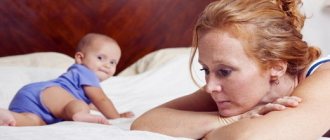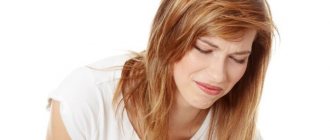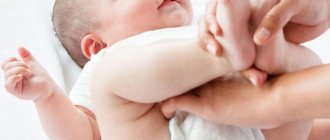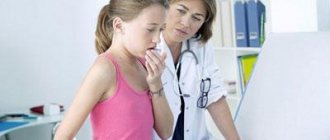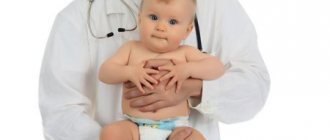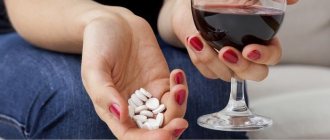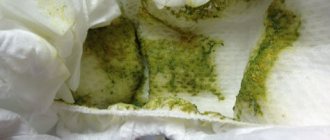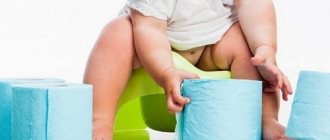Antibiotics are prescribed to children under one year of age only for special indications when the disease is caused by bacteria. Such drugs not only have contraindications, but also have a number of side effects, among which the most common is intestinal dysfunction, manifested in the form of diarrhea.
When prescribing antibiotics, pediatricians anticipate possible dysbiosis and prescribe the simultaneous use of probiotics. These medications help restore normal gastrointestinal microflora and eliminate unpleasant symptoms.
What to do when a baby has diarrhea while being treated with antibiotics? How long does diarrhea last in children? Should I stop taking the medicine?
How do antibiotics behave in the gastrointestinal tract?
Antibiotics are medicines directed against bacteria.
The mechanism of their action depends on the group to which they belong: some destroy the cell membrane of the bacterium, others damage the “internal organs” of the pathogen, and others prevent it from dividing.
The result is the same - the bacterium dies.
Once in the gastrointestinal tract, the medicine is quickly absorbed through the intestinal walls and enters the blood, and with its help it is already distributed throughout the body.
Causes of diarrhea
The effect of antibiotics on the intestinal wall
Diarrhea from antibiotics in a child can be caused by the specific effect of antibiotics on intestinal motility (contractions). Erythromycin makes food and liquids pass through the gastrointestinal tract faster, penicillin accelerates intestinal blood flow (and intestinal function), amoxicillin affects the permeability of the inner lining of the intestine. The result is the same: diarrhea after taking antibiotics, because water does not have time to be absorbed.
Dysbacteriosis
Loose stools when taking antibiotics are most often associated with dysbiosis.
Dysbacteriosis is the massive death of beneficial bacteria in the intestines due to the use of antibiotics.
The latter, unfortunately, do not know how to distinguish between “their” and “foreign” bacteria.
This side effect can cause two consequences: digestive problems (common) and re-infection with pathogenic bacteria due to “free space” (rare).
Pseudomembranous colitis
Some people's intestines contain a bacterium called Clostridium difficile, which is harmful, but under normal conditions the immune system and other bacteria suppress its growth. During dysbacteriosis, the immune system weakens and the number of other bacteria decreases sharply, so Clostridium difficile can begin to multiply uncontrollably. The result is pseudomembranous colitis, which is quite difficult to cure due to the microorganism's resistance to antibiotics. The problem of diagnosis and treatment also lies in the fact that the main symptom of pseudomembranous colitis is diarrhea, and temperature and abdominal pain can be either pronounced or completely absent.
Resistance of pathogenic bacteria to therapy
Evolution works in the following simple way: those organisms that were able to adapt to changed environmental conditions survive, the rest die. Treatment with antibiotics is designed for the first outcome (for bacteria, of course), but some of them can mutate and adapt (this process is generally random). In this case, a repeated outbreak of infection occurs, including all the classic symptoms: nausea, vomiting, diarrhea, fever. Naturally, the same medicine no longer helps.
Allergic reaction
What to do if diarrhea is accompanied by fever, abdominal pain and other symptoms?
Diarrhea caused by taking antibiotics is very common. However, it must be differentiated from diarrhea caused by other causes. These may be intestinal infections, diet disorders and gastrointestinal pathologies.
The main indicator of the inflammatory process is an increase in the child’s body temperature. If it reaches 39-40 C, you should urgently call an ambulance, because there is a direct threat to the baby’s life. Some diseases can progress rapidly, leading to dire consequences. What exactly caused the inflammation will be determined by the doctor in the hospital, where a child with similar symptoms will be admitted.
High temperature, abdominal pain, vomiting, diarrhea are characteristic signs of rotavirus infection, salmonellosis, appendicitis, pancreatitis, gastroenteritis and other diseases. The famous doctor E.O. Komarovsky says that when there is foam, mucus or blood in loose stools, you must definitely call a doctor. Green stool indicates bacterial infection, and black color is characteristic of internal bleeding.
Vomiting combined with diarrhea greatly dehydrates the child's body. Vomiting without diarrhea is considered a negative symptom. Most likely, the reason is not a side effect of taking antibiotics, but an intestinal infection. IVs that will be given to the baby in the hospital will help eliminate water loss.
It is difficult to independently treat a child at home. Intestinal infections require hospitalization, because pathogenic microorganisms can cause an unpredictable response from the body.
Associated symptoms
Vomit
Vomiting in a child indicates that his body wants to get rid of the contents of the gastrointestinal tract. The reasons may be: allergies, re-infection (due to an interrupted course of treatment or resistance), drug poisoning. Vomiting is dangerous because the body loses a lot of fluid and cannot be replenished. Diarrhea complicated by vomiting is a reason to call a doctor.
Abdominal pain
Temperature
An increase in temperature indicates re-infection. The child needs other treatment.
Folk remedies
Traditional medicine offers its own treatment options for children with diarrhea after antibiotics. But before you use them, you should know a few important things:
- In terms of effectiveness, traditional medicine is inferior to traditional medicine, so to the question: “How to treat?” the answer will be: “First – with medications, and then with auxiliary methods”;
- if a child has diarrhea with fever, traditional methods will definitely not help;
- Traditional medicine recipes are contraindicated for infants and children under one year of age.
Traditional medicine recommendations:
- Any compotes that are not made from sour fruits and berries will do. An ordinary compote can help the main treatment well, because it eliminates 2 problems at once: lack of fluid and lack of vitamins.
- Pour boiling water over dried blueberries (spoon) and leave until completely cool. One dose of antibiotics corresponds to one dose of infusion (4 times a day antibiotics - 4 times a day infusion).
- 10 g of mint and 10 g of chamomile are poured with hot water and infused for a day. After adding water to a container with herbs, wrap the container with thick cloth so that the heat comes out more slowly.
- A glass of rice is boiled, the resulting water is given to the child several spoons 5-6 times a day. During cooking, you can add a little salt to the water.
Medicines
Rehydration
Rehydron, powder
Description: contains salts and glucose necessary for the body. Contraindications: kidney problems, severe vomiting. Price: 125 rub. for 10 servings.
If you can’t buy Regidron, you can make a rehydration solution yourself. You need to take a glass of warm water, add a little regular table salt (about the tip of a teaspoon) and a quarter to a half spoon of sugar.
Stir the resulting suspension and give it to drink in small portions.
Symptom relief
Diarrhea in an infant after antibiotics (as in an older child) is usually stopped with sorbents:
Activated carbon, tablets
Description: a cheap and simple product that absorbs excess fluid in the gastrointestinal tract. Contraindications: constipation. Price: 4-6 rub. for 10 tablets.
Smecta, powder for preparing a suspension or suspension
Description: more “advanced” sorbent. Works more effectively than activated carbon. This diarrhea medicine is made especially for children, so it comes in a variety of delicious flavors. Contraindications: intestinal obstruction. Price: 145 rub. for 10 bags of 3 g.
Normalization of microflora
If sorbents and rehydration are used for the initial treatment of newborns and older children, then the further task is to restore the microflora.
Diet, drinking regimen
The diet is very strict. For children over 3 years old with normal or increased body weight, you can even arrange a “hungry day”. This tactic will not work for an infant - he needs to be constantly fed milk.
During diarrhea, everything else is prohibited. After it, you need to stick to a strict diet for another day or two, and then you can restore your diet.
Water and liquids in general can and should be given in large quantities. You can: mineral water, black tea without sugar, compote, plain clean water. You can't: everything else.
Sample menu for the day:
- Morning: tea, rice porridge.
- Day: oatmeal, compote, crackers.
- Evening: tea or mineral water.
Features of treatment of infants
An infant will experience diarrhea more severely than an older child, and there are two reasons for this: unstable intestinal microflora and weak compensatory mechanisms. Therefore, you should not independently treat diarrhea in a newborn caused by antibiotics - you can unknowingly make it even worse. And even more so, you should not use traditional methods. At the “there is diarrhea and something needs to be done” stage, all a parent can do is assess the condition and promptly consult a doctor. Assessment of the condition is simple: if diarrhea in an infant makes itself felt 4 times or less a day, and does not bother the child and looks weak, there is no need to worry. In other cases, you need to talk to your doctor.
Prevention
Prevention of antibiotic-associated diarrhea is difficult because it is poorly dependent on external factors. Two general pieces of advice can be drawn:
- The less often antibiotics are prescribed, the lower the risk of diarrhea and resistance, so self-medication with antibiotics in the early years of a child's life is contraindicated.
- A nutritious and proper diet reduces the risk of diarrhea after antibiotics.
For infants, there is one more point that is often forgotten. Almost all antibiotics pass into breast milk in small quantities. The intestines of an adult would tolerate such a dose without problems, but for a baby this can turn into a disaster and severe dysbiosis. Therefore, it is advisable for nursing mothers to stop breastfeeding during treatment.
Normalization of microflora
What to give a child after antibiotics for diarrhea? Using special preparations, beneficial microorganisms that were destroyed by antibiotics are artificially introduced into the baby’s intestines. The medications are prescribed by the attending physician. Frequently used ones are:
They are dissolved in a small amount of water and drunk before or during meals. The drug is recommended for children from the age of two.
Restoring the intestinal microflora after diarrhea from antibiotics in a child requires a long period, up to several months.
Causes of diarrhea after antibiotics
Diarrhea after antibiotics in a child or an adult is caused by the same circumstance: the massive death of beneficial microflora, which is directly involved in the digestion of food and its absorption.
Antibacterial drugs in many cases become indispensable in the treatment of diseases of the upper respiratory tract, in the postoperative period, etc. But at the same time, they do not have selectivity of action and affect both pathogenic microorganisms and beneficial ones with equal force.
As a result, intestinal dysbiosis develops - a condition in which the delicate balance of microorganisms that formed a healthy microflora is severely disturbed.
If, during antibacterial therapy, a child experiences not only diarrhea, but also vomiting or nausea, this may indicate an allergic reaction to a specific drug or individual intolerance to any of its components.
Since antibacterial therapy is often prescribed in combination with other groups of drugs, they may also play a role in the development of diarrhea.
AAD – antibiotic-associated diarrhea
With the development of powerful antibacterial drugs, the issue of dysbiosis becomes relevant. This problem is important because it is associated with the fact that people self-prescribe treatment, which is often unfounded and associated with many health risks. Unjustified use of antibiotics in children leads to the development of antibiotic-associated diarrhea.
AAD most often occurs in children under 5 years of age in 25% of cases. Diarrhea is caused by the fact that in the child’s intestines the number of antibiotic-sensitive bacteria decreases, and resistant strains appear that should not normally exist. They damage the intestinal walls, lead to their inflammation, and increase the secretion of water in the lumen.
Antibiotics that cause AAD:
- erythromycin;
- cephalosporins;
- tetracyclines;
- ampicillin;
- benzylpenicillin.
Signs of AAD in a child appear already during treatment, and in every third case 7-10 days after therapy. Profuse and watery diarrhea develops. Then cramping pain occurs, the intensity of which decreases after bowel movement. Sometimes babies develop a fever. In severe cases, the following dangerous conditions develop:
- severe dehydration and sudden loss of body weight;
- toxic expansion of the intestinal walls;
- perforation (rupture) of the colon.
Treatment of diarrhea after antibiotics
If your child has diarrhea while taking antibiotics, especially if loose stools are accompanied by nausea or vomiting, be sure to consult a doctor before completing the course of treatment. The pediatrician can replace the drug with another one so as not to interrupt the course of therapy and at the same time reduce the load on the gastrointestinal tract.
The first thing you should do when diarrhea starts is to ensure your child is getting fluid replacement. These do not necessarily have to be water-electrolyte solutions. Pure water, berry fruit drinks, fruit juices without pulp, weak tea - such drinks will help prevent dehydration.
You should definitely adjust your child’s diet by excluding sweets, baked goods, foods high in fat and fiber, and carbonated drinks. It is better to give preference to well-cooked porridges, lean varieties of meat and fish, boiled or stewed in their own juice, and baked potatoes.
The doctor may recommend using eubiotics - drugs that help maintain and restore normal intestinal microflora - along with taking antibiotics.
It should be remembered that diarrhea, which is allegedly caused by taking antibiotics, may hide various diseases that require timely diagnosis and treatment. Therefore, if within one day the child’s stool does not return to normal or even becomes more frequent and loose, and the general condition can be called unsatisfactory, be sure to contact your doctor.
How are antibiotics related to the gastrointestinal tract in a child?
It is important to remember that only a doctor should prescribe antibiotics to a child. Under no circumstances should you do this yourself, without first taking tests and conducting an examination.
Any antibiotics, in addition to the expected assistance in eliminating harmful bacteria, also have a detrimental effect on beneficial microorganisms. First of all, when using antibiotics, it is the intestinal microflora that suffers, the destruction of which leads to indigestion, expressed in diarrhea and active gas formation. Often these symptoms are also accompanied by nausea and vomiting.
The use of antibiotics almost always causes a sharp decrease in immunity, which is quite difficult to restore, especially if we are talking about a child’s body that is still fragile.
Treatment of diseases in a child with the help of such serious drugs should only be in extreme cases, when there is no other way out or way to help the baby. For example, in cases where it is impossible to cure a disease without the use of antibiotics, since it cannot be treated by other means and poses a threat to the child’s life.
IMODIUM ® Express for diarrhea in children
IMODIUM ® Express is an antidiarrheal drug that can be used to treat diarrhea in children starting from 6 years of age. It promotes the onset of action within an hour after administration and helps to normalize intestinal motor function, reduce the volume of water released into the intestinal lumen and normalize the absorption of water and salts in the intestine. Together, this allows you to reduce the frequency of the urge to defecate and eliminate loose stools.
Antibiotics are an effective way to treat many diseases. The baby’s immune system is unable to cope with external bacteria and viruses on its own due to its formation. One of the complications that can arise after taking antibiotics is a malfunction of the baby’s gastrointestinal tract and, as a result, diarrhea. The use of these drugs is not recommended for infants.
Causes of diarrhea
To prevent the occurrence of severe complications, these medications are prescribed by a doctor. The main reasons that can cause diarrhea after antibiotics in an infant are:
- disruption of intestinal microflora and, as a result, dysbacteriosis;
- the digestive tract is irritated by the action of the drug components;
- pseudomembranous colitis.
When a doctor prescribes antibiotics for a child, it is advisable to resort to narrowly targeted drugs. A medicine with a broad spectrum of action will destroy not only pathogenic bacteria, but also all other components of the intestinal flora.
Digesting food after taking antibiotics becomes difficult due to a significant reduction in beneficial bacteria. The number of yeast fungi may increase, which provokes increased gas formation. A baby under the age of six months still finds it difficult to cope with the high content of air in the intestines.
Diarrhea in an infant is calculated by the number of bowel movements per day, and not by the consistency of the stool. Foamy stool indicates problems with the newborn's gastrointestinal tract. It is especially dangerous when blood appears repeatedly in the stool. This may indicate a violation of the integrity of the mucous membranes of the gastrointestinal tract.
Drug treatment
The first thing to do when a child has diarrhea is to understand how dangerous it is. In some cases, the baby may require specific treatment. Contact your doctor if:
- the child defecates more than 5 times per day;
- he has a high body temperature;
- diarrhea is very watery;
- there is a lot of mucus in the stool, there is blood or pus;
- when pressing on the stomach, severe pain occurs;
- the baby has stopped urinating, is lethargic, his lips are dry and red (signs of dehydration).
When the child's overall condition is stable, diarrhea after antibiotics can be treated at home. To do this, you should work closely on restoring the intestinal microflora. Bifidobacteria and lactobacilli, which are contained in pre- and probiotics, help populate it with beneficial bacteria. The drugs “Linex”, “Enterol”, “Hilak-Forte”, “Bifiform”, “Acipol” are especially popular.
Important! To prevent dehydration, if your child has frequent diarrhea, you should give him plenty of water and also give him Regidron or another rehydration solution.
Attention! If your child continues to take antibiotics, it is very important to report diarrhea to the doctor. Most likely, the dose of the drug will be reduced or it will be replaced with another one.
Symptoms
Parents of the baby can independently determine diarrhea in the baby. After taking antibiotics, the baby's tummy appears bloated. In this case, the body temperature is within normal limits, the newborn does not cry, and there may be no abdominal pain. With severe intoxication of a tiny organism, the temperature rises. The child becomes restless. People around you can hear rumbling in your tummy, and the passing of gas becomes loud. Intestinal contents may leak with them. The baby may refuse to eat. A dangerous symptom is a combination of diarrhea and vomiting. Mothers should be able to distinguish between excessive spitting up and vomiting in young children.
Forms of diarrhea
When taking antibiotics, there can be several forms of diarrhea:
- Mild - loose stools are observed no more than five times a day, with mild painful sensations that go away after defecation. Feces do not contain any impurities or strong odor and have a watery consistency.
- Moderate - loose stools occur up to fifteen times a day, body temperature rises, pain increases, and vomiting occurs. There is mucus in the stool, and there may be streaks of blood.
- Severe – severe diarrhea in a child after antibiotics, bowel movements up to thirty times a day. Body temperature rises to forty degrees, vomiting appears, and rapid dehydration occurs. The skin takes on a bluish appearance, the mouth becomes dry, cracks appear on the surface of the tongue and lips, and urination stops.
- Fulminant – the development of all symptoms occurs rapidly. The child suffers from severe abdominal pain and the frequency of bowel movements increases. Mucus and blood appear in the stool, and vomiting begins. Rapid dehydration occurs and urgent medical attention is required.
Treatment
Treatment of diarrhea in newborns should begin after the first warning signs. If the child's stool character changes during use, the drug must be discontinued. There is a high probability of dehydration of a fragile body. If a baby has frequent bowel movements, it is necessary to give fluids, even if the baby is completely breastfed. Parents often neglect this rule. Ignoring the loss of water in the body can lead to serious consequences.
It is not recommended to treat diarrhea in an infant yourself. The right decision would be to contact a pediatrician. Only a doctor can select effective therapy and remedies that correspond to the age of the baby.
The treatment regimen involves three stages of treatment:
- normalize the water-salt balance in the body;
- make stool thicker;
- restore non-pathogenic bacteria that will populate healthy intestinal microflora.
Medicines that are approved from birth will help restore water balance and can be purchased at a pharmacy without a prescription form. After taking antibiotics of various spectrums, it is recommended to take a course of probiotics or prebiotics. They will help restore the healthy flora of the damaged organ. If symptoms increase, vomiting or fever occurs, you should call an ambulance and go to the hospital under the supervision of a doctor. First aid provided independently can temporarily alleviate the baby’s condition. You should not resort to traditional medicine methods.
To make the child's stool thicker, special preparations are used. In this case, parents must follow the rules for using the product. Exceeding the recommended dose can lead to difficulty bowel movements. The stool is too thick.
It is not advisable to rely on the recommendations of friends and acquaintances who have encountered a similar situation. Children are individual, as are the severity of the effects of taking medications.
Diet as a method of treating diarrhea
To successfully cure diarrhea after taking antibiotics, it is necessary to approach the problem comprehensively. An important role in this scheme is assigned to diet correction. Without this point, the body’s recovery process can be significantly delayed. We wrote on this page what you can feed a child with diarrhea.
For children under one year of age who are breastfed, the ideal dietary option is only breast milk. But for this, the nursing mother will have to go on a diet with her baby. It is recommended to exclude from the diet all foods that, to one degree or another, can cause stool thinning. At the same time, it is advisable to add bananas, baked apples and rice to the menu.
We recommend: Causes and treatment of diarrhea in children during teething - basic recommendations
For artificial ones, it is recommended to prepare the mixture by diluting milk with water in a ratio of 1:2. After a day, you can switch to 1:1 proportions, provided there is a noticeable improvement in the child’s condition. You can return to your normal diet after two to three days.
For children over one year old who are already familiar with adult food, it is suggested to prepare dishes from potatoes, rice, buckwheat porridge and heat-treated vegetables. For treats, you can offer your child homemade crackers, dried apples and baked green apples.
If a child has diarrhea, it is forbidden to give any fermented milk products until the stool normalizes. Kefir and natural yoghurts are allowed only with confirmed dysbiosis, when the frequency of trips to the toilet is reduced.
Among folk remedies, we can recommend an infusion of dill seeds, a decoction of chamomile or black peppercorns without chewing. But first, consult a pediatrician so as not to harm the baby’s condition.
Restoration of microflora
If the child received complementary foods before illness, then it is necessary to temporarily discontinue all foods that contain acids and irritate the intestines. The nutrition of a nursing mother should be reviewed taking into account the child’s condition. If the baby is not allergic to cow protein, the woman is recommended to introduce fermented milk products into her diet. When breastfeeding, some of the beneficial bacteria will enter the baby's body.
There is no need to limit your child's diet. It should be familiar, but in reduced proportions. The feeding time interval becomes shorter. This will allow the gastrointestinal tract to normalize its activity without causing gagging.
If the child is bottle-fed, then the solution to restore water balance is taken two hours before the main meal.
The most difficult stage is restoring the baby’s intestinal microflora. The course can last up to six months. It is not recommended to make decisions on your own about what means will contribute to this. The doctor will base this on the results of the tests performed.
You can add low-fat broth and compotes that you prepare yourself to your child’s diet. Eating jelly is especially beneficial. Puree from bananas and apples promotes intestinal motility. If the child has teeth, you can offer to chew bread crackers cooked in the oven without spices.
If the child is recovering, then fermented milk products can be gradually introduced into the diet. The bacteria they contain will have a beneficial effect on the restoration of healthy microflora. You can use both store-bought products and those you make yourself using dry starter.
The information on our website is provided by qualified doctors and is for informational purposes only. Don't self-medicate! Be sure to consult a specialist!
Author: Rumyantsev V. G. Experience 34 years.
Gastroenterologist, professor, doctor of medical sciences. Prescribes diagnostics and carries out treatment. Expert of the group for the study of inflammatory diseases. Author of more than 300 scientific papers.
What to do if your child has diarrhea after taking antibiotics
Since frequent loose bowel movements lead to severe dehydration, the child should be provided with plenty of fluids. And to replenish the water balance, salt solutions are used, for example, Regidron. To reduce side effects, antibiotic treatment in children should be accompanied by the intake of prebiotics and probiotics, which replenish the supply of vital microorganisms that help normalize the digestive system and suppress pathogenic microbes. Such drugs include Enterol, Hilak-forte, Bifidumbacterin, Linex, Biosporin, Lacidofil, Bifiform Baby and many other drugs that should be taken only as prescribed by a doctor. If taking these drugs does not bring the desired result and diarrhea continues to develop, treatment with the prescribed antibiotic is stopped and replaced with another drug. To eliminate the symptoms of diarrhea in a child at home, it is recommended to follow a certain diet that excludes fatty foods, vegetables, fruits, milk and take activated charcoal, Smecta or Zincite, which are the safest medications for the child’s body.
Diet for the treatment of diarrhea in children
The child should receive enough fluids to replenish the body's water balance. Water must be clean; carbonated and sweet drinks and juices are excluded. It is recommended to give the child low-fat broths, compotes, mineral water, tea, and jelly. The first day, food can be completely replaced with drink, and on the second day, you can make rice water or, if there is no vomiting, give a little boiled rice or baked potato. Foods that irritate the intestinal mucosa should be excluded from the diet: fruits, vegetables, carbonated water, fatty foods, smoked foods, spices. The only fruits you can use for diarrhea are banana or applesauce. Rusks are a very good fixing agent.
After the child’s condition improves, it is recommended to start taking fermented milk products, which will restore the intestinal microflora and normalize its functioning. You can make a wonderful fermented milk product yourself. To do this, you need to add a spoonful of sour cream or sour cream to milk brought to a temperature of forty degrees and let it stand in a warm place for about eight hours. Food and drink should be supplied to the body often, but in small portions. If you have diarrhea, you should not eat pasta, flour and butter products, and sweets, which increase intestinal activity.
Traditional methods of treating diarrhea in children
Traditional recipes are an excellent additional remedy, and sometimes even a self-sufficient method for treating multiple diseases, and diarrhea is no exception. To treat this disease in children, you can use the following methods:
- Prepare an infusion of St. John's wort. To do this, you need ten grams of dried leaves of the plant, which are poured with a liter of boiling water. Then leave for thirty minutes and filter. Children are given fifty milliliters three times a day.
- Pour two tablespoons of dried blueberries with a glass of boiling water. You can cook or leave for ten minutes. Take one spoon every hour.
- An aspen decoction made from a tablespoon of herb and a glass of water, which is boiled for several minutes. Take one teaspoon five times a day.
- Brew a teaspoon of wormwood in two glasses of boiling water, leave for about twenty minutes. The child should be given fifty milliliters four times a day.
- Make an infusion of three tablespoons of dill seeds and two glasses of boiling water, which is consumed one hundred milliliters several times a day.
- Mix equal amounts of yarrow, oregano and chamomile flowers. Pour two teaspoons of the mixture into a glass of boiling water and cook for ten minutes. Children are given a glass before each meal.
- Ten teaspoons of chamomile flowers are poured into two glasses of cold water and left for eight hours. The children's dosage is one teaspoon four times a day before meals.
